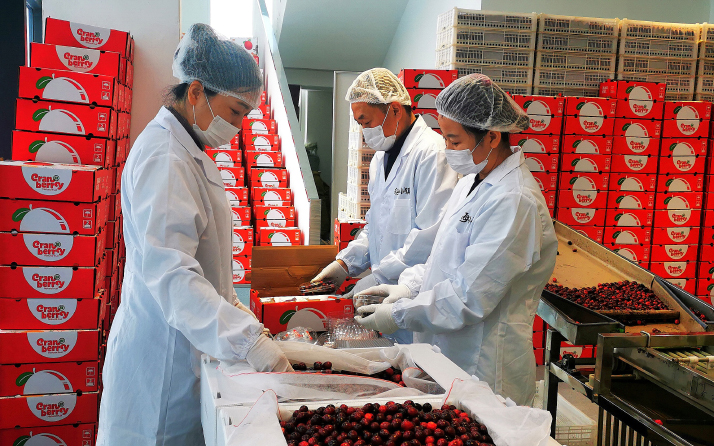| China |
| Region reveal a treasure trove of local produce | |
|
|
 Two women from northeast China (right) hand out boxes of cranberries to residents in Nanning, Guangxi Zhuang Autonomous Region, on January 11 (XINHUA)
Regional authorities have been presenting and exchanging local specialties in recent weeks, unveiling a hidden treasure trove of delicacies. The trend of gift exchanging is occurring amid a burgeoning wave of tourism after Harbin, the provincial capital of Heilongjiang, became the focus of all eyes for its local attractions. The trend has sparked a chain of joyful surprises as people unexpectedly learn that the origins of some well-known foods are none other than their hometown. The first local specialty that caught public attention during the gift exchanging was cranberries from Heilongjiang. Last December, Harbin City extended a warm welcome to a visiting kindergarten group from Guangxi Zhuang Autonomous Region in south China. In a heartfelt expression of thanks, Guangxi sent a bountiful gift of 200 tons of their sun-kissed local oranges to Harbin. With equal generosity, Harbin shipped 100,000 boxes of their cranberries to Guangxi. However, the news about the cranberries shocked many Heilongjiang residents, given many of them had never heard that their province is a cranberry powerhouse contributing 44 percent of Asia's output of the fruit. "We had always imagined cranberries to be a southern fruit, or perhaps an import," a Heilongjiang local said in a video uploaded on China's short video platform Douyin. Some locals even wondered: How is it that we, the denizens of cranberry heartland, have never savored a fresh cranberry? Inspired by the exchange of oranges and cranberries, other regions began to follow suit by showcasing their specialties, bringing similar surprises to residents who previously had no idea about these hometown products. Unexpected delicacies Sichuan Province, famed for its spicy cuisine, captured the spotlight during a local delicacy exchange with Heilongjiang when it presented caviar. Caviar, from Sichuan? As it turns out, the city of Ya'an—better known as the land of the giant pandas—is also the unexpected site of China's second largest caviar production facility, a fact that has remained largely under the radar for many of its own residents. The parade of regional specialties continued to astonish. Guizhou Province, with its rugged terrain, turned out to be the primary source of green tea powder for Japan. Around 70 percent of the green tea powder found on Japanese shelves originates from the hills of Guizhou. One netizen shared her astonishment upon making this discovery, recounting how she verified the origin of a jar of green tea powder she had purchased in Japan, only to find it indeed came from Guizhou. "So I traveled all the way to Japan only to bring back something that was grown right at home?" she asked online. Following Sichuan, other landlocked provinces emerged as burgeoning centers for the production of aquatic delicacies. Shanxi, nestled far from the coast, has surprisingly become a hub for the cultivation of hairy crabs. Gansu, with its vast arid expanses, has made a name for itself with the successful farming of the South American white shrimp. In an equally surprising twist, Xinjiang Uygur Autonomous Region, which is often associated with its rich mutton dishes and famous barbecue cuisine, has also carved out a significant niche as a major supplier of fresh salmon. Shanghai, a cosmopolitan city in the east, is responsible for 90 percent of China's saffron production. This is particularly intriguing since many assume that saffron can only grow on the Qinghai-Xizang Plateau. Additionally, Anhui Province, also in the east, is recognized as a significant producer of foie gras. These discoveries have thrust these regional products into the limelight. Data from Taobao, China's premier online shopping platform, revealed that in the early days of January, searches for cranberries on the site increased by almost 10 times. Li Feng, who is in charge of a cranberry growing base in Fuyuan, Heilongjiang, revealed that the province's cranberries have only hit the market in the last couple of years—hardly enough time to boast about them to the locals. "Fuyuan has a similar latitude to that of the world's major cranberry-producing areas, making it a suitable new home for the fruit," Li told Farmers' Daily. "Research on cranberry cultivation in Heilongjiang began in 2010, and the planting began in 2014." After a patient wait of three years for the first fruit and five years for a full harvest, Heilongjiang's cranberry industry has made a remarkable leap. In 2023, the region harvested an impressive 2,700 tons of cranberries, filling a void in the market that had previously depended entirely on imports.  Workers at a cranberry growing base in Fuyuan, Heilongjiang Province, box up cranberries on January 12 (XINHUA)
Cultivation and innovation The South American white shrimp farmed in Gansu is also a relatively new testament to agricultural innovation. In Jingtai County, one of Gansu's major hubs for production of the shrimp, research on farming this aquatic species began only in 2018. Nestled along the banks of the Yellow River, Jingtai has historically battled severe soil salinization, which has left vast expanses of land barren and saline-alkali laden. In a transformative initiative, the county has turned these once-forsaken lands into fertile grounds for salt-alkali aquaculture, harnessing the saline-alkali water for productive use. The South American white shrimp, known for its robust adaptability, was selected as a prime candidate for this initiative. Ma Guibin, who leads a local farmers' cooperative, told China Central Television (CCTV) that the cooperative embarked on the shrimp project in 2022. They have since developed a recirculating aquaculture system, conserving water and controlling all environmental factors that may affect the stocked organism. In May 2023, the first harvest of white shrimp reached the market to great acclaim, with sales exceeding expectations. Anticipation is high for the next batch, which is slated for release during the Spring Festival holiday, from February 10 to 17 this year, with a projected output between 8,000 and 9,000 kg. In contrast to the nascent status of these products in China, Sichuan's caviar industry boasts a longer history. The province first ventured into caviar production over a decade ago. Today, China is a caviar powerhouse, providing some 60 percent of the global supply. Tianquan County in Ya'an contributes a significant one fifth of China's total caviar production, with the majority of its yield being exported to over 30 countries and regions. The foie gras industry in Anhui has an even more extensive history. Dating back to the 1980s, the foie gras industry in Huoqiu County in Lu'an City has become China's most productive, engaging over 140 goose breeding enterprises and generating in excess of 5,000 tons of foie gras annually. "As caviar and foie gras are not staples in the traditional Chinese diet, many such products are primarily aimed at the export market, leaving many in China unaware of their existence," Hu Bingchuan, a researcher from the Chinese Academy of Social Sciences, told CCTV. "The recent exposure of these products has provided a good opportunity for them to gain recognition among Chinese consumers and carve out a niche in the domestic market." Echoing this sentiment, Li Jun, a caviar producer from Sichuan, told Sichuan Daily about the surge in interest from domestic buyers following caviar's rise in prominence. "We have seen a significant uptick in inquiries from new domestic clients and have been receiving numerous orders from the local market," Li said. "We will intensify our efforts to tap into the domestic market." Copyedited by G.P. Wilson Comments to yuanyuan@cicgamericas.com |
|
||||||||||||||||||||||||||||
|